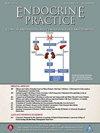Continuous Subcutaneous Hydrocortisone Infusion in Adrenal Insufficiency: Practical Experience in 33 Subjects
IF 3.7
3区 医学
Q2 ENDOCRINOLOGY & METABOLISM
引用次数: 0
Abstract
Objectives
Diminished subjective health status and increased mortality have been reported in people with adrenal insufficiency (pwAI) receiving conventional glucocorticoid replacement therapy. Continuous subcutaneous hydrocortisone infusion (CSHI) permits individualized glucocorticoid delivery and mimics a more physiologic cortisol pattern compared with oral glucocorticoid therapy. However, data are limited regarding patient selection for CSHI, optimal dosing of CSHI, and CSHI impact on relevant clinical outcomes.
Methods
We performed a single-center, retrospective longitudinal cohort study in 33 consecutive pwAI offered a therapeutic trial of CSHI due to persistent AI symptoms.
Results
Our cohort comprised of 33 pwAI (82% women). Nine (27.3%) had primary adrenal insufficiency, 16 (48.5%) had secondary AI, and 8 (24.2%) had glucocorticoid-induced AI. The median total daily dose of glucocorticoid (in hydrocortisone equivalent) decreased from 30 mg/d (range, 15-180 mg) before CSHI to 26.7 mg/d (P = .013) at CSHI initiation and 26.6 mg/d (P = .023) at last encounter. The median number of ED visits/year due to adrenal crisis decreased from 0.5 (range, 0-3.4) to 0 (P = .002) and median number of hospitalization days/y decreased from 0.2 (range, 0-18) to 0 (P = .019) after switching to CSHI. There was a numerical increase in subjective health scores (SF-36 survey) following CSHI use. No significant differences were noted for change in weight, blood pressure, diabetes, cardiovascular/cerebrovascular events, total cholesterol, LDL, and/or triglyceride concentrations pre and post CSHI. At study conclusion, most patients (84.8%) remained on CSHI based on personal preference and tolerability.
Conclusions
CSHI is a safe and effective means of delivering individualized glucocorticoid therapy to pwAI.
持续皮下注射氢化可的松治疗肾上腺功能不全:33例的实践经验。
目的:据报道,在接受常规糖皮质激素替代治疗的肾上腺功能不全(pwAI)患者中,主观健康状况下降,死亡率增加。与口服糖皮质激素治疗相比,持续皮下氢化可的松输注(CSHI)允许个体化糖皮质激素输注,并模拟更生理性的皮质醇模式。然而,关于CSHI的患者选择,CSHI的最佳剂量以及CSHI对相关临床结果的影响的数据有限。方法:我们在33个连续的pwAI中进行了一项单中心、回顾性纵向队列研究,提供了因持续AI症状引起的CSHI的治疗试验。结果:我们的队列包括33名pwAI(82%为女性)。9例(27.3%)为原发性肾上腺功能不全,16例(48.5%)为继发性AI, 8例(24.2%)为糖皮质激素所致AI。糖皮质激素(氢化可的松当量)的中位每日总剂量从CSHI前的30 mg/天(范围,15-180 mg)下降到CSHI开始时的26.7 mg/天(p=0.013)和最后一次接触时的26.6 mg/天(p=0.023)。改用CSHI后,肾上腺危象导致的ED就诊中位数/年从0.5(范围0-3.4)降至0 (p=0.002),住院天数中位数/年从0.2(范围0-18)降至0 (p=0.019)。使用CSHI后,主观健康评分(SF-36调查)有数值上的增加。CSHI前后体重、血压、糖尿病、心脑血管事件、总胆固醇、LDL和/或甘油三酯浓度的变化无显著差异。在研究结论中,大多数患者(84.8%)基于个人偏好和耐受性继续使用CSHI。结论:CSHI是一种安全有效的pwAI个体化糖皮质激素治疗方法。
本文章由计算机程序翻译,如有差异,请以英文原文为准。
求助全文
约1分钟内获得全文
求助全文
来源期刊

Endocrine Practice
ENDOCRINOLOGY & METABOLISM-
CiteScore
7.60
自引率
2.40%
发文量
546
审稿时长
41 days
期刊介绍:
Endocrine Practice (ISSN: 1530-891X), a peer-reviewed journal published twelve times a year, is the official journal of the American Association of Clinical Endocrinologists (AACE). The primary mission of Endocrine Practice is to enhance the health care of patients with endocrine diseases through continuing education of practicing endocrinologists.
 求助内容:
求助内容: 应助结果提醒方式:
应助结果提醒方式:


